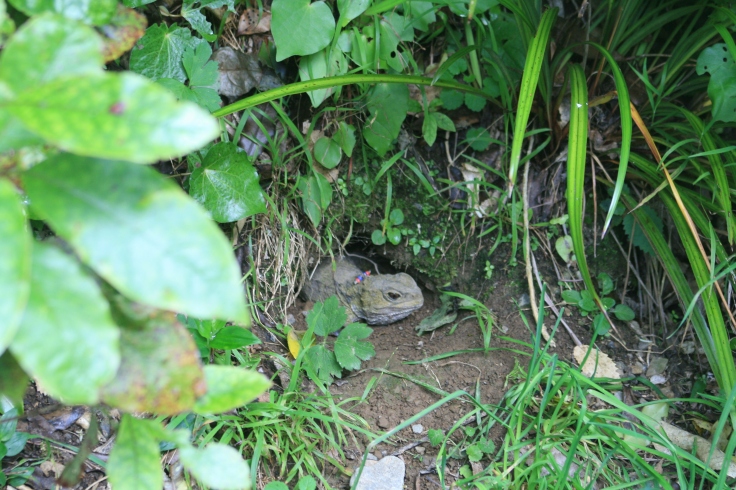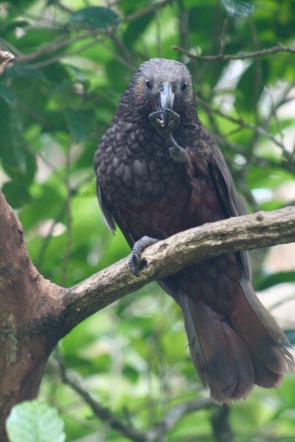Alright everyone, strap on your seat-belts, we’re taking a detour! As an ecologist, I just couldn’t pass up the opportunity to discuss a conservation strategy that (to my knowledge) is unique to New Zealand: the “predator-free” ecosanctuary. This past week, I visited Wellington’s very own ecosanctuary, Zealandia and I was just blown away!
Something that I find especially fascinating about New Zealand is that there are no native mammals in this country aside from three species of bats. This means that the native wildlife here are not adapted to survive mammalian predators. For example, Kakapo, one of a number of flightless bird species, are slow to reproduce and simply freeze when a predator approaches rather than trying to get away. While this behavior would allow them to survive in the face of avian predators like the New Zealand Falcon, it also makes them easy pickings for introduced species like rats, stouts, and cats.
So what’s a country to do? The New Zealand Department of Conservation (DOC) oversees a number of fantastic national parks throughout the country. However, despite their best efforts it is next to impossible to remove all invasive species from these area since they are open to the surrounding landscape of agriculture and urban development.
Enter the ecosanctuary. In 1995, the Karori Sanctuary Trust was established as a non-profit community organization with the vision “to be a world-class conservation site portraying our natural heritage that captures people’s imagination, understanding and commitment”. In the following years, a decommissioned reservoir in the suburbs of Wellington was transformed into the world’s first fully fenced ecosanctuary.
This predator-proof fence is specifically designed to cope with rabbits, possums, cats, and every mammalian pest except for mice (those devious jerks). This means that Zealandia can effectively cut off this corner of the world to restore it to a more natural state. While it is impossible to revert this valley to its original state (I have been mourning the extinction of the Moa since I landed in this country), Zealandia has reintroduced 18 species to this area, including the Kaka, Tieke (or Saddleback), and Tuatara.

In the years since, these species have flourished within Zealandia’s borders. The second you enter the sanctuary, your ears are bombarded by birdsong that appears to be oddly lacking in most other places in New Zealand. When I visited for the first time a few days ago, the Kakas were practically dripping from the trees! Not only have their numbers increased within the sanctuary, but surrounding suburbs are now experiencing the halo effect of this protected area. Streets that haven’t seen Kakas in years now have frequent visits from these feisty parrots.
After viewing Zealandia’s success, other ecosanctuaries, such as Orokonui, have set up their own fences with similar success. These “predator-free” sanctuaries simply would not work in other countries because mammalian predators are native almost everywhere else in the world. This is what makes me nerd out so much about what New Zealand is doing with these ecosanctuaries and predator-free islands. They are essentially taking the introduced pest and removing it from the conservation equation with much success.

Now, as much as I am gushing here, the concept of the ecosanctuary is also somewhat depressing. In order to have such success with species reintroductions, conservationists had to completely cut off this bit of land from everything around it. I find this somewhat sad since in an ideal world, humans would be able to interact with nature without having such a strong, negative impact. Still, each act of conservation is a step forward in my book. It really is quite incredible to see what Zealandia has done in a relatively short period of time. Now if only I had a shot of being alive to see their 500 year vision come to fruition!
Anyway, I know this is a little bit of a divergence from the typical travel-related musings, but there will plenty more of those to come! Did you like this tangent? Have your own opinions about the ecosanctuary concept? Leave a comment below! I’ll see you again next week with some thought provoking words about the magic that is peanut butter.

Things like the ecosanctuaries make me proud of the conservation efforts our little corner of the world is making 😊
LikeLiked by 1 person
It’s really unique! I’ve never seen anything like it before! And I really just can’t get over how many Kakas I saw while I was there!!
LikeLike
G’day Mate!!!
Nice blog. These Ecosanctuaries are sweet as. I loved Ulva Island. One of my favourite spots in NZ.
Now I got a question for you: Why are there no native mammels in that amazing corner of the world? That bothered me from the very first day of my trip.
Cheers, Tim
PS: I’m thinking about running my own B&B now ;b
LikeLike
Hey! Thanks! Yeah, Ulva Island was fantastic!! As for the mammal question there’s two theories and they aren’t mutually exclusive. The first is that New Zealand broke away from the super continent, Gondwana, before mammals really evolved, so they simply hadn’t established themselves there. The other is that New Zealand was entirely submerged at some point in time, which would have killed off any mammals that had found their way there. In either case, that meant that the only animals that could feasibly get to New Zealand from say Australia were those that could fly. And you totally should haha! Just make sure you actually wash the duvet covers…
LikeLike
Loved this blog post! As a Kiwi ecologist, this makes me proud to read :). I also spend half the year as an ecologist in the UK, and it is very interesting contrast as our countries ecologies are so different!
LikeLike